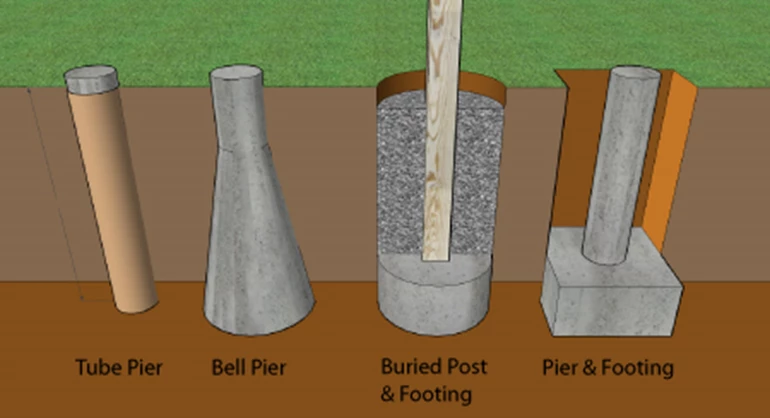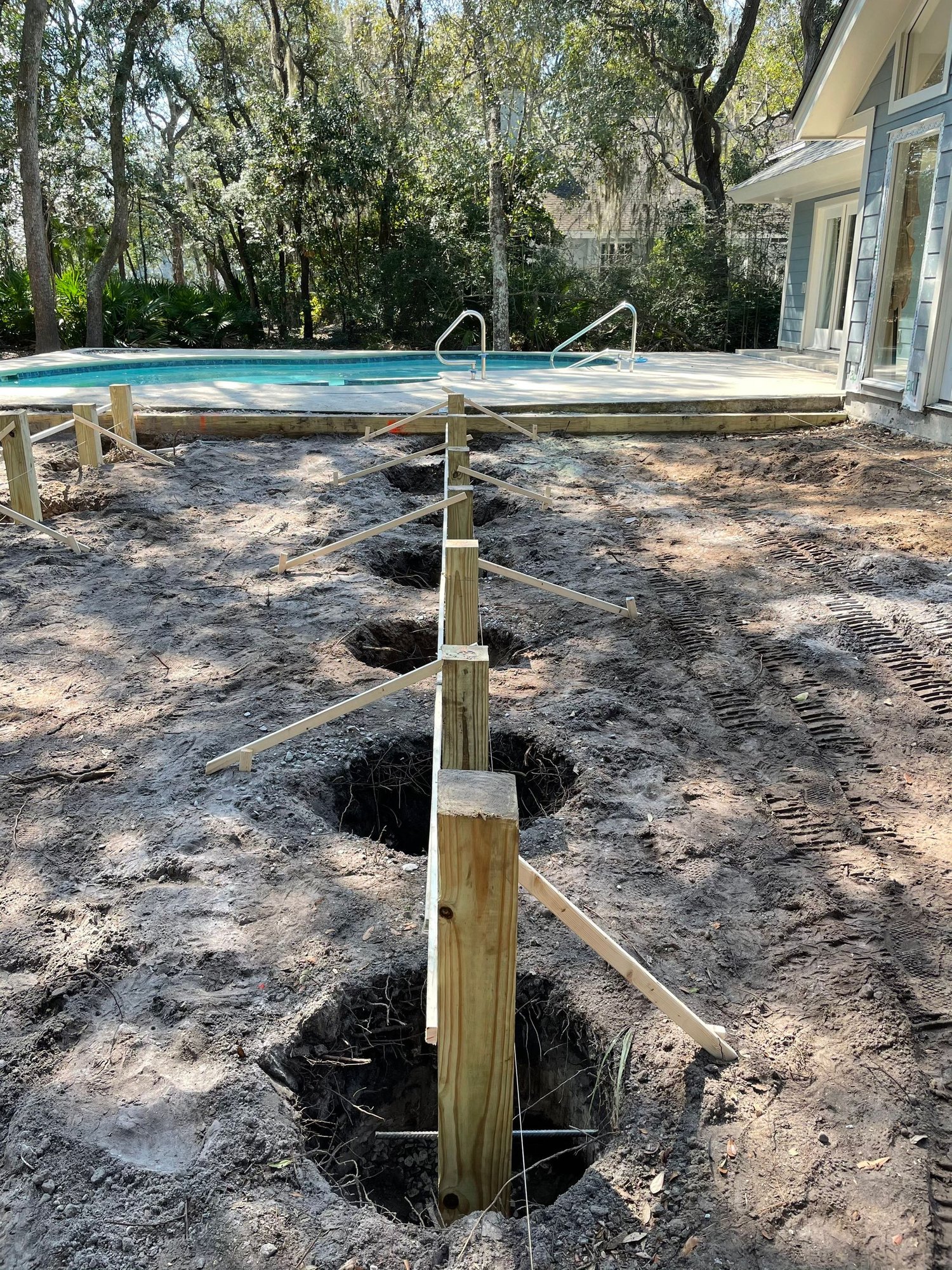Step-by-Step Deck Excellence: Making Certain Stability with Properly Set Up Deck Footings
Step-by-Step Deck Excellence: Making Certain Stability with Properly Set Up Deck Footings
Blog Article
Make Best Use Of the Life Expectancy of Your Deck With Strong and trusted Grounds
As property owners, we invest a substantial amount of time and resources right into developing the excellent exterior space. A deck is frequently the focal point of that space, giving a location to relax, entertain, and enjoy the appeal of nature. Nevertheless, in order to totally make the most of the life expectancy of your deck, it is vital to ensure that it is developed on trusted and strong grounds. These footings form the foundation of your deck, supplying stability and assistance, and are frequently the difference in between a deck that lasts for decades and one that calls for continuous fixings. In this conversation, we will certainly discover the significance of dependable footings, the various kinds of strong footing materials, appropriate installation methods, and just how to preserve and examine your deck's grounds to stop damage. So, whether you remain in the procedure of constructing a new deck or looking to enhance the long life of your existing one, join us as we discover the secrets to a deck that stands the test of time.
Value of Dependable Grounds
When it comes to making best use of the life-span of your deck,The value of trusted grounds can not be overemphasized. The grounds function as the structure upon which the whole structure rests, supplying stability and support. Without a strong footing, the deck is prone to shifting, sinking, and even collapse, which can dramatically lower its life-span and present safety and security risks.

Selecting the appropriate kind of ground is additionally vital. The most common types include concrete footings, helical piers, and sonotubes. Variables such as soil problems, climate, and the size of the deck will certainly figure out the most appropriate choice. Working with a specialist to examine the dirt, style the grounds, and guarantee appropriate installment is very suggested.
Spending in reliable grounds might involve extra cost and initiative upfront, but it is a beneficial investment that will certainly add to the lasting toughness and security of your deck. By guaranteeing a strong foundation, you can enjoy your deck for several years to come, understanding that it is developed to withstand the test of time.
Types of Solid Footing Products
To make sure the stability and longevity of your deck, it is crucial to think about the different sorts of strong footing products readily available. The choice of footing material is vital as it supplies the essential assistance and security to hold up against the weight and tons of the deck framework.
One reputable and usual product made use of for deck footings is concrete. Concrete footings are resilient and give outstanding security. They can be put straight right into the ground or use precast concrete footings for easier installation. One more option is helical piers, which are steel shafts with helical plates that are screwed into the ground. These piers use exceptional load-bearing ability and can be utilized in various dirt problems.
For locations with inadequate soil problems, such as loose or extensive dirts, a ground system that uses steel or composite piers might be favored. Deck Footings. These piers are driven deep into the ground to reach steady dirt layers, making certain the security of the deck
In many cases, deck footings can likewise be built using treated lumber. It is crucial to ensure that the lumber is appropriately dealt with to stand up to rot and decay triggered by exposure to wetness and bugs.
When selecting a ground material for your deck, it is important to consider variables such as dirt problems, environment, and neighborhood building codes. Consulting with an expert contractor or architectural designer can assist identify one of the most suitable ground material for your particular deck project.
Proper Installment Methods for Footings
Thinking about the relevance of guaranteeing security and longevity for your deck, it is necessary to comprehend the correct setup methods for grounds. The success of your deck task relies greatly on the stability of its structure, which is why following the right setup methods is vital.
Most importantly, it is needed Visit Website to determine the proper dimension and deepness of the footings based on the style and load needs of your deck. This information can be gotten from constructing codes or via appointment with an architectural designer. As a general guideline, footings ought to go to the very least 12 inches in diameter and prolong listed below the frost line to avoid changing or settling.
When the dimensions are developed, the next step is excavation. Digging the holes for the footings should be made with accuracy, seeing to it they are deep adequate and have a level base. Deck Footings. This will certainly give a stable base for the footings
To further improve the stability of the grounds, it is advised to utilize a concrete blend with a strength of at the very least 3,000 psi. This will certainly make sure the grounds can stand up to the weight and forces applied by the deck.
During setup, it is necessary to maintain the grounds degree and aligned correctly. This can be accomplished by making use of a degree and string lines to lead the placement of each ground.
Preserving and Evaluating Your Deck's Grounds
Normal upkeep and complete examinations are vital for making certain the long-lasting stability and security of your deck's footings. Over time, grounds can give in to damage, climate problems, and dirt movement, which can compromise their architectural honesty. To maximize the life expectancy of your deck's footings, it is critical to apply a routine maintenance routine and perform detailed evaluations.

Additionally, it is vital to evaluate footings for any kind of signs of damages or wear and tear. This includes checking for splits, splits, or collapsing concrete, along with any kind of indicators of motion or settlement. Any kind of issues should be addressed quickly to stop more damages and make sure the security of the deck.
Additionally, it is suggested to inspect the bordering soil for any kind of indicators of erosion or moving. Dirt movement can impact the security of the grounds, so it is essential to deal with any kind of soil-related problems without delay.
Signs of Ground Damages and Just How to Address Them
Footing damages can pose major risks to the stability and security of your deck, making it necessary to without delay recognize and deal with any type of indications of deterioration. Among one of the most typical indications of footing damage is sinking or working out of the deck. This visit can happen because of dirt erosion, poor footings, or inadequate construction techniques. If you see that your deck is unequal or leaning, it is crucial to take instant action to stop further damage. An additional sign of footing damage is cracking or collapsing of the concrete grounds. This can be brought on by freeze-thaw cycles, extreme moisture, or low quality concrete. If you observe any fractures or damage in the footings, it is important to have them evaluated and repaired by a specialist. In addition, if you notice any type of motion or shifting of the deck, such as a deck that really feels unpredictable when strolled on or totters when weight is applied, it can be a sign of footing damage. In such instances, it is advised to seek advice from an architectural designer or a specialist specialist to evaluate the degree of the damage and identify the suitable course of action. Keep in mind, resolving ground damages quickly can help make certain the long-lasting stability and safety and security of your deck.
Final Thought
To conclude, making sure the integrity and toughness of grounds is important for making the most of the life expectancy helpful site of your deck. By using strong footing materials and correctly installing them, you can prevent damages and maintain the stability of your deck. Routine upkeep and evaluations will certainly additionally help identify any type of signs of footing damage and enable for prompt repair services. Inevitably, taking these actions will certainly aid maintain the integrity and longevity of your deck.
These grounds create the foundation of your deck, providing stability and assistance, and are often the distinction between a deck that lasts for decades and one that calls for consistent repair services. In this discussion, we will explore the relevance of trustworthy footings, the different types of strong ground materials, appropriate installment strategies, and how to preserve and inspect your deck's footings to prevent damage.Normal maintenance and comprehensive examinations are crucial for guaranteeing the long-term security and safety of your deck's grounds. Bear in mind, resolving footing damages without delay can aid guarantee the long-term stability and security of your deck.
By utilizing solid footing materials and effectively mounting them, you can protect against damage and keep the stability of your deck.
Report this page